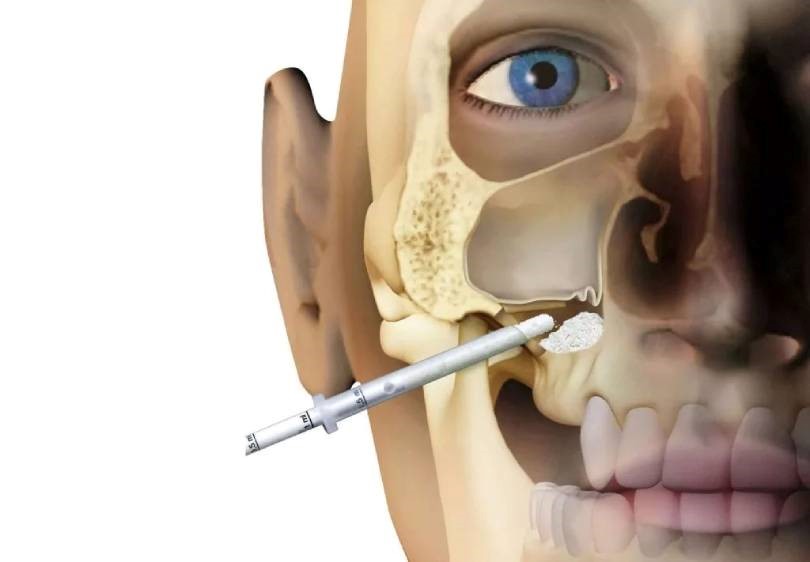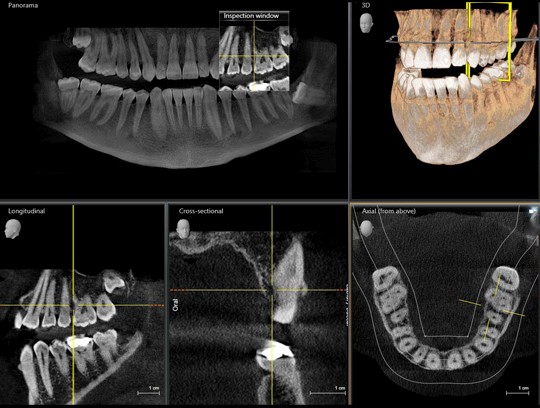
In order to place an implant in a patient, the surgeon must carefully analyze the patient's CT scan and plan the surgical procedure in detail and as accurately as possible.
Bone grafting is necessary when there is insufficient bone to place an implant. There are cases when a patient has been missing a tooth for years, resulting in bone atrophy. In this case, additional manipulations such as bone grafting or sinus-levator may be necessary.
Depending on whether the upper or lower jaw requires bone grafting, the type of manipulation will be different. On the upper jaw, a so-called sinus elevator is performed; on the lower jaw, bone grafting surgery is performed. Sinus elevator is a manipulation to enlarge the bone tissue in the maxillary sinus area, i.e. on the upper jaw.
Bone augmentation is performed using the patient's bone substitute or bone graft.
How is bone grafting performed at Mary Care Dental Clinic in Pechersk?
Bone grafting is carried out in several stages:
1. anesthesia. The operation can be performed under local anesthesia or under sedation (medication sleep);
2. antiseptic treatment of soft tissues of the oral cavity;
3. A gingival incision can be performed with a WaterLase Ierbium laser or a scalpel;
4. Bone grafting of bone substitute and membrane is performed;
5. Application of sutures.
This manipulation can be done in conjunction with dental implants or separately, depending on the patient's clinical situation and takes 1-2 hours.
The healing process takes two to three months, but in some very rare and complicated cases it takes about eight months. It all depends on the clinical situation and the patient's body.
What are the main rules for following the recommendations after bone grafting?
Basic rules after bone grafting?
- You should not blow your nose;
- Do not sneeze or puff up your cheeks;
- Chew your food thoroughly in the area where the surgery was performed;
- You should eat soft food, ground in a blender;
- Use only a soft or medium-hard toothbrush;
- do not drink drinks through a straw;
- Do not overheat the side where the surgery was performed;
What complications after bone grafting make you come in for a checkup?

- Some patients experience complications after this surgery. There are swelling, bruising and elevated body temperature, slight bleeding in the area of surgery, but it is very important that these symptoms do not last more than three to four days, if they last longer, it may indicate the beginning of complications. After two weeks, you can return to your normal lifestyle, but until then you will have to follow all the doctor's recommendations for some time in order not to harm your health.
- If the headache does not go away within seven days, it indicates that there is inflammation in the maxillary sinus due to developing maxillary sinusitis or other inflammatory reactions. If the headache does not go away, and especially if it gets worse, you need to see a doctor, as this could be a sign of bone rejection.
- The stitches should be removed no later than two weeks after the soft tissue has healed. There are cases where the sutures may come apart due to physical exertion or poor quality suture material. Mary Care Dental Clinic uses very strong and durable suture materials, so the sutures can only come apart if the doctor's recommendations are not followed. In this case, the wound will open, there will be bleeding and there is a risk of infection entering the wound, which can lead to complications or rejection of the bone material.
- Numbness or loss of sensation in the surgical area should go away within 24 hours, after which sensation usually returns. In rare cases, loss of sensation is due to nerve damage during surgery. Our specialists plan the surgery with the help of a carefully studied CT scan, which allows us to see the location of the nerve branches and nodes, so the risk is reduced to almost zero.





